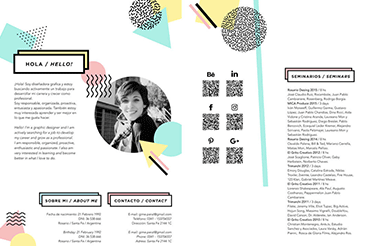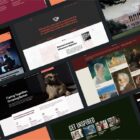
Even if you aren’t actively looking for a job, your resume is an important piece of your digital portfolio. From sites such as LinkedIn to personal portfolio pages such as Behance that showcase your work, glimpses into your design career are everywhere.
You want to control that message to ensure that you are putting the right vibe out there about who you are, the work you do and why (quite frankly) you are a rock star designer. And while a stellar portfolio is a great way to start that conversation, your resume is equally important. It should highlight some of the skills that aren’t as apparent from looking at a few marquee pieces.
As a bonus, every example resume here is a template from Envato Elements. Visit and download usable graphic design assets to boost your resume design today!
2 Million+ CV & Resume Templates, Cover Letters + More
Download thousands of resume templates, cover letters, and many other design elements, with a monthly Envato Elements membership. It starts at $16 per month, and gives you unlimited access to a growing library of over 2,000,000 presentation templates, fonts, photos, graphics, and more.
1. Problem-Solving Ability
You solve problems every day. That’s the essence of good design. It creates a visual solution that communicates something to others. Your resume needs to show that you can do more than just make something pretty; it needs to show that you can develop solutions.
How can you do this? Provide examples or case studies that present problems that you have solved in the cover letter that you attach to a resume or in the portfolio section of the document. Explain how you developed an idea with a team and executed it in a manner that created a great end product.
2. Marketing
Some of your marketing skills will inevitably show up in the resume itself. You need to have some marketing knowledge and background so that you can both sell design projects (and yourself to a potential client or employer).
Make it your job to understand concepts in SEO, advertising and how companies are targeting and reaching customers. You don’t have to be an expert, but should be able to talk logically about these concepts and understand them enough to include them in your resume.
3. Print Knowledge
Most clients and firms will tell you they need a design team that’s flexible and can complete a variety of tasks. One of those includes printed design. While much of the design conversation tends to center around digital concepts, it is just as important to know how to create something and get it printed, from posters to packaging labels to billboards.
Make sure to include some printed projects in your portfolio and verse yourself in formats, colors, and moving projects from digital to print and back. Just as important as understanding how to create printed items is working with vendors or other third parties to produce these elements.
4. Digital Design Knowledge
If you are someone who has always focused on print, you need to get versed in digital design today. And if you are already fluent in website design, make sure to include that information, including programming languages, content management system platforms, and relevant tools that you can use with ease.
One of the things that often happens as we put together a resume, is that you forget all the things you know, almost taking for granted that everyone has the same skills. When it comes to a resume, it is important to note all relevant items because many job sites use these keywords to “read” and sort resumes based on potential fits. You don’t want to miss an opportunity because you forgot to list skills you consider to be second nature.
5. Basic HTML
Be honest and upfront about your level of HTML and code understanding. How much you need can vary greatly by position, but in today’s job market it is almost always important.
Even design candidates with basic HTML skills can beat out candidates without these skills. Can you read HTML? Write a little? Are you versed enough to change stylesheets in an existing website design? Include this information.
6. Software
Most job postings will note what software skills are important, but any fluency in design tools should be standard on your resume. As with HTML, consider including notations for software that you have certifications or particular expertise in.
Designers will almost always find that including the Adobe Create Suite is a great starting point. Further note which programs within the toolset you use regularly. (Remember those keywords!) Don’t pack your resume with software that is so common that everyone should be able to use it. If you are fluent in Adobe InDesign, you can probably leave off that you know how to use Microsoft Word.
7. Social Media and Networking
Your network will follow you everywhere. Even from job to job, this is important and most employers want to see that you know how to use social media and can do it well. This often extends to your personal accounts (if they are public) and knowledge of how to create design elements for these platforms.
Make sure you understand the differences in the major channels and they type of visual elements they use. Include social media links to your public or professional profiles so that others can see how well you have mastered the tools.
8. Flexibility and Time Management
Nobody likes a diva designer. You know the one that gets one project, hogs it for months, and then flips out at any suggestion to make a change. Employers are equally terrified of this unknown and want to know that you are flexible, can be part of a team, and manage your time and tasks well.
This is one of those soft skills areas that can be a little tough to visualize as you put the resume together. Consider a few strong verbs that show your skills in a way that isn’t full of clichés. (Consider this a creative challenge.)
9. Understanding of Typography
If it’s not readable, what’s the point? Every designer needs to have a good understanding of typography. Again, this is one of those skills that you might almost forget to mention. But what sets you out from the pack when you think about lettering?
Have you drawn your own typeface? Do you have a particular style or flair for combining words and letterforms? While you can list these skills on your resume, it is also a great place to show that you understand how to pair type and create killer content that’s easy to read and look at.
10. Communication
At the end of the day, it all comes down to communication. How good of a designer you are parallels to how well you communicate. While visual communication is vital, written and spoken communication are also important. Are you a great public speaker? Have you taught classes or held seminars?
Include these elements in your resume as proof of performance. Examples of excellent ability to communicate can help you stand out from a crowd. These skills are quite valuable on a daily basis. Team members who communicate well are going to find it easier to work on projects with a team and share and sell ideas.
Conclusion
From hard skills such as technical ability to soft skills like teamwork and flexibility, your resume is someone else’s first glimpse into your professional self.
Your resume should include the right keywords to help you make it through screening processes, but then contain enough information about your abilities to make you stand out. Keep your resume current and consider posting a version online to complement your portfolio. You never know where the next opportunity might be waiting.
CV & Resume Templates
A thoughtfully designed CV or resume can help you stand out from other candidates, and make a memorable first impression. It isn’t enough to use the standard template in MS Word—you need to be thinking more creatively! In this series, we’re sharing tips, advice and templates for creating the perfect CV or resume!















